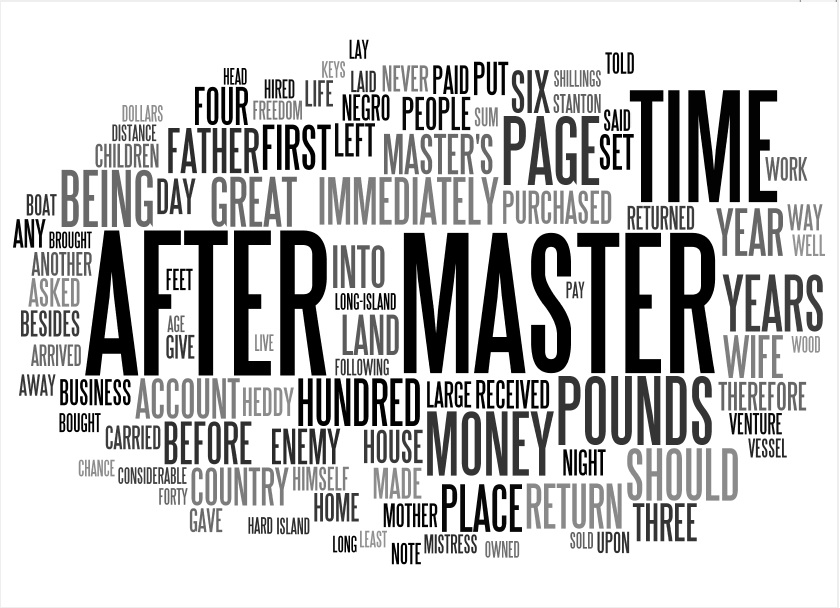Text Analysis of Venture Smith’s Narrative
After reading Lisa Spiro’s latest blog post addressing text analysis for comparison based research, I decided to try out some of these tools for myself. For my text I chose the narrative of Venture Smith, who was the subject of my senior thesis. Smith was an eighteenth-century black man who was kidnapped and sold into slavery as a child in Africa, labored as a slave in New England for several decades, then managed to buy the freedom of himself and his family and become a successful businessman. He narrated an autobiography near the end of his life that is becoming more and more widely used by educators. Following Spiro’s example, I went over to Wordle and created a word cloud of the narrative. Here are the results:
A cursory glance at the cloud shows some basic results. The first recurring text theme was that of MASTER, not surprising given the amount of time he spends discussing his time as a slave. The second theme was that of time (TIME, YEAR, YEARS, AFTER). As an elderly man at the time of his narration, this is also not surprising, and supports the overall sense of reflection one gets from reading the text. Finally, the third theme is that of money (MONEY, POUNDS, PURCHASED, BUSINESS, PAID). One of the striking, and at times disconcerting, aspects of Smith’s narrative is a near-obsessive focus on all things financial. He recounts detailed transactions, including placing the purchase of his pregnant wife’s freedom in terms of the money he saved from not having to purchase his yet-unborn son.
I then went over to TAPOR and used a basic word frequency tool to examine the list. The advantage of this tool over the word cloud at Wordle is that you can set more parameters, including the exclusion of “stop words,” such as “a, the, and, etc.” that comprise the majority of text. Controlling for these stop words, here are the top twenty words in Venture Smith’s narrative:
What is surprising is the sheer frequency of the word “master,” far outstripping any other other word. If we combine “money” and “pounds” together, it would be roughly comparable, however. The middle column displays the location within the text, divided into segments. For example, it shows that master was almost exclusively utilized during the middle third of the text, or a close correlation to the middle chapter of the narrative describing his time as a slave. Simiarly, “money” and “pounds” come up most often during the last third of the text, during which time Smith was a free man and likely more concerned with financial issues.
In order to move beyond simple text frequency, I decided to examine some key words. My thesis explored the role of land and property in Smith’s life as a freeman, so I used TAPOR’s visual cocollator tool and created a basic diagram of the words that appeared most often in the two sentences surrounding the word “land”. From there, I decided to link up a similar visual diagram for the word “time” in order to see any links between these two often-used, but seemingly unrelated phrases:
The two main words that linked “land” and “time” were “money” and “purchased.” It is interesting that the common connector between these two elements of Smith’s life seemed to be a financial one. Or perhaps it points to the fact that his focus on money seemed to permeate many other aspects of his worldview and identity. If I had more time I’d like to do a comparative analysis, similar to Spiro’s, to other contemporary black narratives (Olaudah Equiano, John Marrant, etc.). A lot of room for possibility here.

